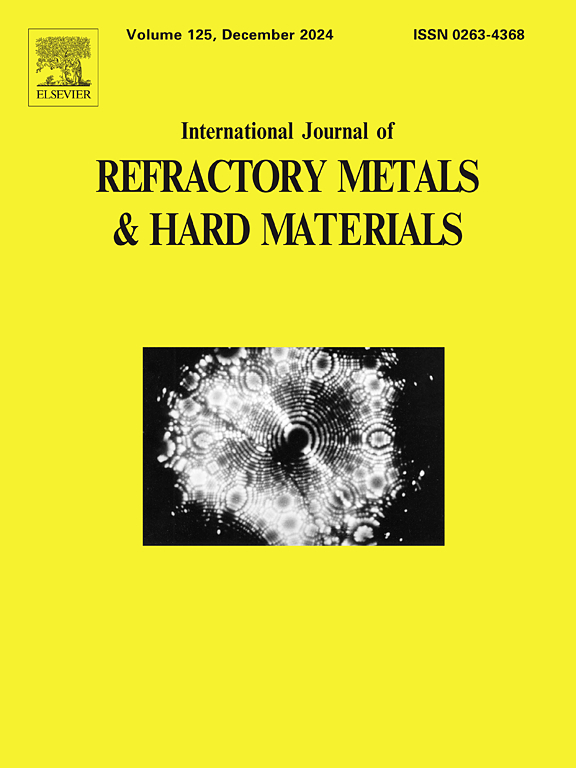Enhanced properties of a WMoTaTi refractory high entropy alloy via a face-centered cubic phase
IF 4.2
2区 材料科学
Q2 MATERIALS SCIENCE, MULTIDISCIPLINARY
International Journal of Refractory Metals & Hard Materials
Pub Date : 2025-03-21
DOI:10.1016/j.ijrmhm.2025.107157
引用次数: 0
Abstract
Refractory high entropy alloys (RHEAs) are gaining widespread attention recently due to their excellent high-temperature properties. In this study, a WMoTaTi RHEA was fabricated by laser-based powder bed fusion of metals. The microstructure features with nanosized semi-coherent ductile face-centered cubic titanium (TiFCC) precipitates in the body-centered cubic (BCC) matrix. The oxygen enrichment and significant thermal stresses induced by the PBF-LB/M process contributed to the formation of TiFCC precipitates. The semi-coherent TiFCC/matrix interface and the ductile nature of TiFCC reduced the cracking defects and greatly improved the printability of the WMoTaTi RHEA, while retaining excellent high-temperature performance. The compressive strengths of the as-printed WMoTaTi RHEA at 25, 1000 and 1600 °C are 1251.2 ± 19.5 MPa, 1159.3 ± 10.6 MPa and 96.4 ± 4.3 MPa, with the compressive strains of 6.7 ± 1.1 %, 18.3 ± 2.3 % and >30.0 %, respectively. The nanoscale TiFCC phase underwent a transformation-induced plasticity (TRIP) process from TiFCC to hexagonal close-packed Ti (TiHCP). The solid solution and secondary phase precipitates mainly contributed to the high strength, and the TRIP effect led to substantial plasticity at elevated temperatures for the as-printed WMoTaTi RHEA. This work offers a novel avenue for designing RHEAs with well printability and desirable performance.
面心立方相增强WMoTaTi难熔高熵合金的性能
耐火高熵合金(RHEAs)由于其优异的高温性能而受到广泛关注。在本研究中,采用激光粉末床熔合金属制备了WMoTaTi RHEA。研究了体心立方(BCC)基体中纳米级半相干延性面心立方钛(TiFCC)的微观结构特征。PBF-LB/M工艺引起的氧富集和显著的热应力是TiFCC沉淀形成的主要原因。半相干TiFCC/基体界面和TiFCC的延展性减少了裂纹缺陷,大大提高了WMoTaTi RHEA的可打印性,同时保持了优异的高温性能。打印的WMoTaTi RHEA在25、1000和1600℃时的抗压强度分别为1251.2±19.5 MPa、1159.3±10.6 MPa和96.4±4.3 MPa,压缩应变分别为6.7±1.1%、18.3±2.3%和30.0%。纳米级TiFCC相经历了从TiFCC到六边形密排Ti (TiHCP)的相变诱导塑性(TRIP)过程。固溶相和二次相析出是导致WMoTaTi RHEA高强度的主要原因,TRIP效应导致WMoTaTi RHEA在高温下具有良好的塑性。这项工作为设计具有良好印刷性和理想性能的rhea提供了一条新的途径。
本文章由计算机程序翻译,如有差异,请以英文原文为准。
求助全文
约1分钟内获得全文
求助全文
来源期刊
CiteScore
7.00
自引率
13.90%
发文量
236
审稿时长
35 days
期刊介绍:
The International Journal of Refractory Metals and Hard Materials (IJRMHM) publishes original research articles concerned with all aspects of refractory metals and hard materials. Refractory metals are defined as metals with melting points higher than 1800 °C. These are tungsten, molybdenum, chromium, tantalum, niobium, hafnium, and rhenium, as well as many compounds and alloys based thereupon. Hard materials that are included in the scope of this journal are defined as materials with hardness values higher than 1000 kg/mm2, primarily intended for applications as manufacturing tools or wear resistant components in mechanical systems. Thus they encompass carbides, nitrides and borides of metals, and related compounds. A special focus of this journal is put on the family of hardmetals, which is also known as cemented tungsten carbide, and cermets which are based on titanium carbide and carbonitrides with or without a metal binder. Ceramics and superhard materials including diamond and cubic boron nitride may also be accepted provided the subject material is presented as hard materials as defined above.

 求助内容:
求助内容: 应助结果提醒方式:
应助结果提醒方式:


